Several nights ago the chill of interstellar space refrigerated the countryside as temperatures fell well below zero. That didn’t discourage the likes of Orion and his seasonal friends Gemini, Perseus and Auriga. They only seemed to grow brighter as the air grew sharper.
Wending between these familiar constellations like a river steaming in the cold was the Milky Way. The name has always been slightly confusing as it refers to both the milky band of starlight and the galaxy itself. Every single star you see at night belongs to our galaxy, a 100,000 light-year-wide flattened disk scintillating with over 400 billion suns.

Earth, Sun and planets huddle together within the mid-plane of the disk, so that when we look straight into it, the density of stars piles up over thousands of light years to form a thick band across the sky. Since most of the stars are very distant and therefore faint, they can’t be seen individually with the naked eye. They blend together to give the Milky Way a milky or hazy look.

In a snowstorm, we easily distinguish individual snowflakes falling in front of our face, but looking into the distance, the flakes blend together to create a white, foggy haze. Replace the snowflakes with stars and you have the Milky Way – with a caveat. If we lived in the center of our galaxy, the sky would be milky with stars in all directions just like that snowstorm, but since the Sun occupies the flat plane, they only appear thick when our line of sight is aimed along the galaxy’s equator. Look above and below the disk and the stars quickly thin out as our gaze pierces through the galaxy’s plane and into intergalactic space.
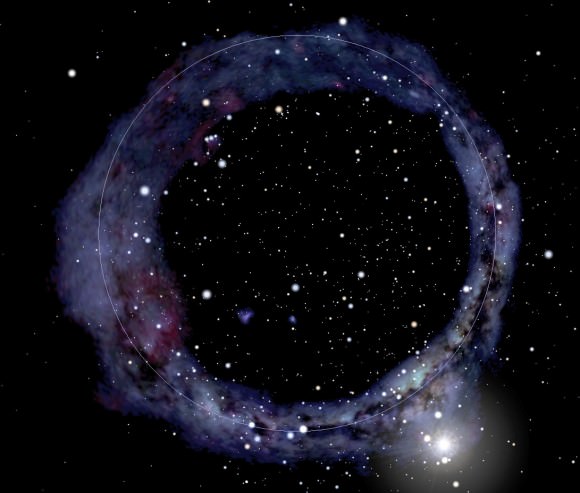
If you could float in space some distance from the brilliant ball of Earth, you’d see that the Milky Way band passes above, around and below you like a giant hula-hoop. Back on the ground, we can only see about two-thirds of the band over the course of a year. The other third is below the horizon and visible only from the opposite hemisphere, providing yet another good reason to make that trip to Tahiti or Ayers Rock in Australia.
Few know the winter version of the Milky Way that stands above the southeastern horizon around 10:30-11 p.m. local time on moonless nights in early December. No surprise, given it hardly compares to the brightness of the summertime version. This has much to do with where the Sun is located inside the galaxy, some 30,000 light years away from the center or more than halfway to the edge.
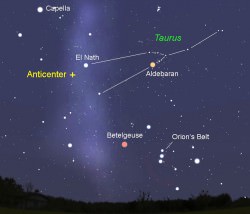
On late fall and winter nights, our planet faces the galaxy’s outer suburbs and countryside where the stars thin out until giving way to relatively starless intergalactic space. Indeed, the anticenter of the Milky Way lies not far from the star El Nath (Beta Tauri) where Taurus meets Auriga. While the hazy band of the Milky Way is still visible through Auriga and Taurus, it’s thin and anemic compared to summer’s billowy star clouds.
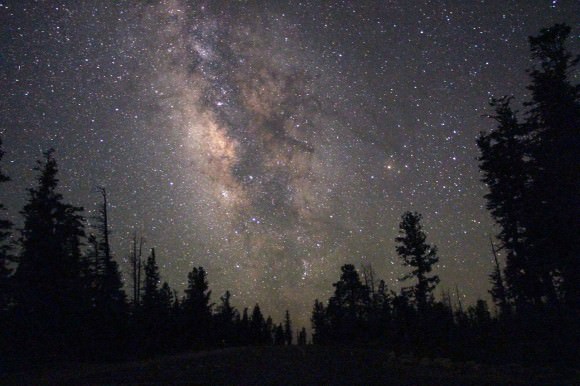
At nightfall in July and August, we face toward the galaxy’s center where 30,000 light years worth of stars, star clouds and nebulae stack up to fatten the Milky Way into a bright, chunky arch on summer evenings compared to winter’s thin gruel.
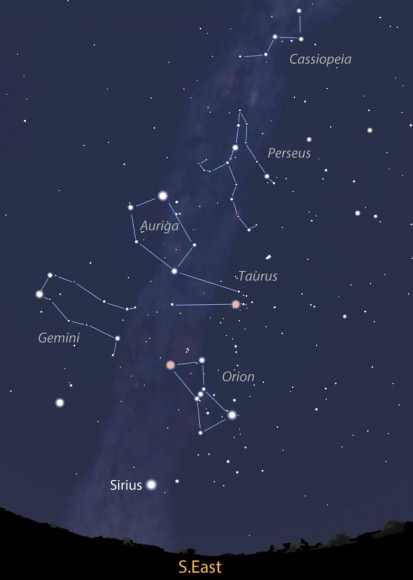
The winter Milky Way starts east of brilliant Sirius and grazes the east side of Orion before ascending into Gemini and Auriga and arching over into the western sky to Cassiopeia’s “W”. Binoculars and telescopes resolve it into individual stars and star clusters and help us appreciate what a truly beautiful and rich place our galactic home is.
Few sights that impress us with the scope and scale of where we live than seeing the Milky Way under a dark sky during the silence of a winter night. Picture Earth and yourself as members of that glowing carpet of stars, and when you can’t take the cold anymore, enjoy the delicious pleasure of stepping inside to unwrap and warm up. You’ve been on a long journey.

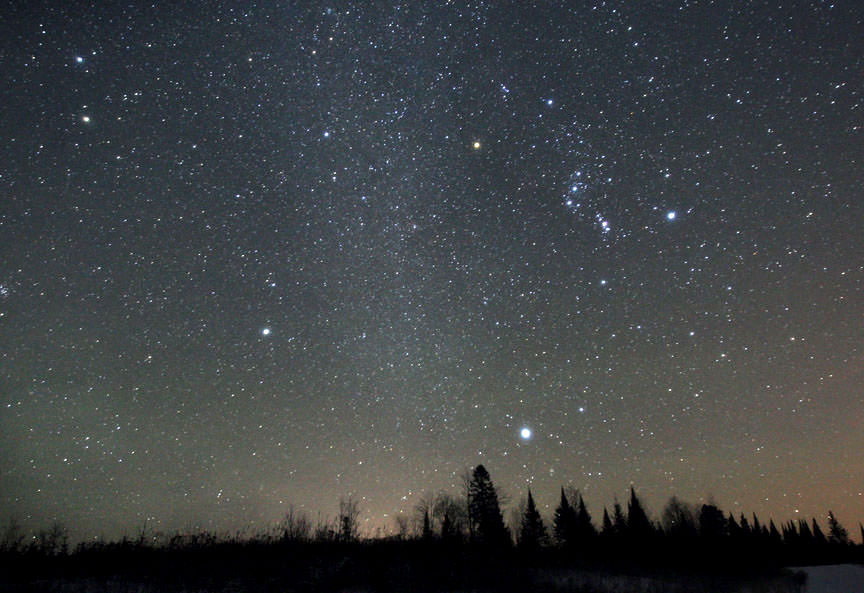
I really like those cold winter nights when the moisture completely freezes out of the atmosphere and the seeing can become phenomenal. Of course frozen dew on the collector plate is no fun and neither is frostbite! But the rewards of viewing a clear winter sky perhaps after a storm, makes it all worth while. A little hot coffee or tea helps. And then toward the end of the session, a little Irish Whiskey (Anti-freeze) to take off the edge?
Aqua4U,
All of the above make it a little easier to venture outside on these cold nights. I usually prefer tea. Holding the cup with both hands and feeling that warmth is one of life’s great little joys.
Am drinking a cupa Jasmine Green with a dab of honey and a squeeze of lemon presently. Mmm… Cheers!
Yeah.. I’ve been known to put a shot of some good Irish Whiskey in my last cup of tea. But since night vision is impaired by alcohol, nicotine, and low blood sugar.. it’s generally not a good idea at the eyepiece.
Agreed Albone. Seeing is rough over here too, though it’s best when the weather in winter’s most wicked – windy nights. Calm nights when the temperature drops continuously are the worst because my mirror never cools down adequately.
Thank you Bob for this highly comprehensive article. The sight of that area of the sky has captured the imagination of many over the past tens of thousands of years and is no different today, once people lift their gaze up from their “smart” devices…
Cold weather observing needs a little adaptation from our bodies but being clothed for the conditions, keeping it simple with staying close to home, using tested instruments that requires little fumbling along and being ready for the night’s events (time of objects rising, satellite opportunities, Kp index monitoring) and when the need comes to temporarily retreat to the warmth inside, good company that appreciate the “nut” that we all are.
Well time to head back out,
Actual temp.: 9°F (-13°C).
Could be worse really 🙂
BC,
Well spoken as always. We were (are) both out tonight. 2 F here and windy, but now-and-again breaks to warm up have made the night a pleasure. I’ve been out examining carbon stars and the Moon. No Milky Way till late!
I’m working in Pincher Creek, Alberta this year and the temp last night was -33c with 13km/hr winds. Sorry Milky Way, I’ll have to catch you some other time. 🙂
I know that area fairly well as I’ve been in Penticton for …ok, let’s not go there . Only 3 more days until temperate relief (spelled c-h-i-n-o-o-k) comes to the eastern slopes of the Albertan Rockies on Thursday. 🙂
Hey Bob how did you get the stars so big in the top photo? Did you use a filter on your lens? If so, what?
When I use the dslr to take wide angle photos of stars (focused correctly) they remain as little spots, and are hard to see, even in longer exposures.
Hi Arnold,
Good eye and excellent question. I use a very light diffusion filter during one-third of the exposure time. It brings the brighter stars out (puffs them up a bit) so they appear more like they do with the naked eye. Longer use of the filter will make even bigger stars but the view becomes unacceptably soft. This was a 30-second exposure and I filtered for 9 seconds.
Thank you for the answer.
Guess I’ll be getting a light diffusing filter then 😀